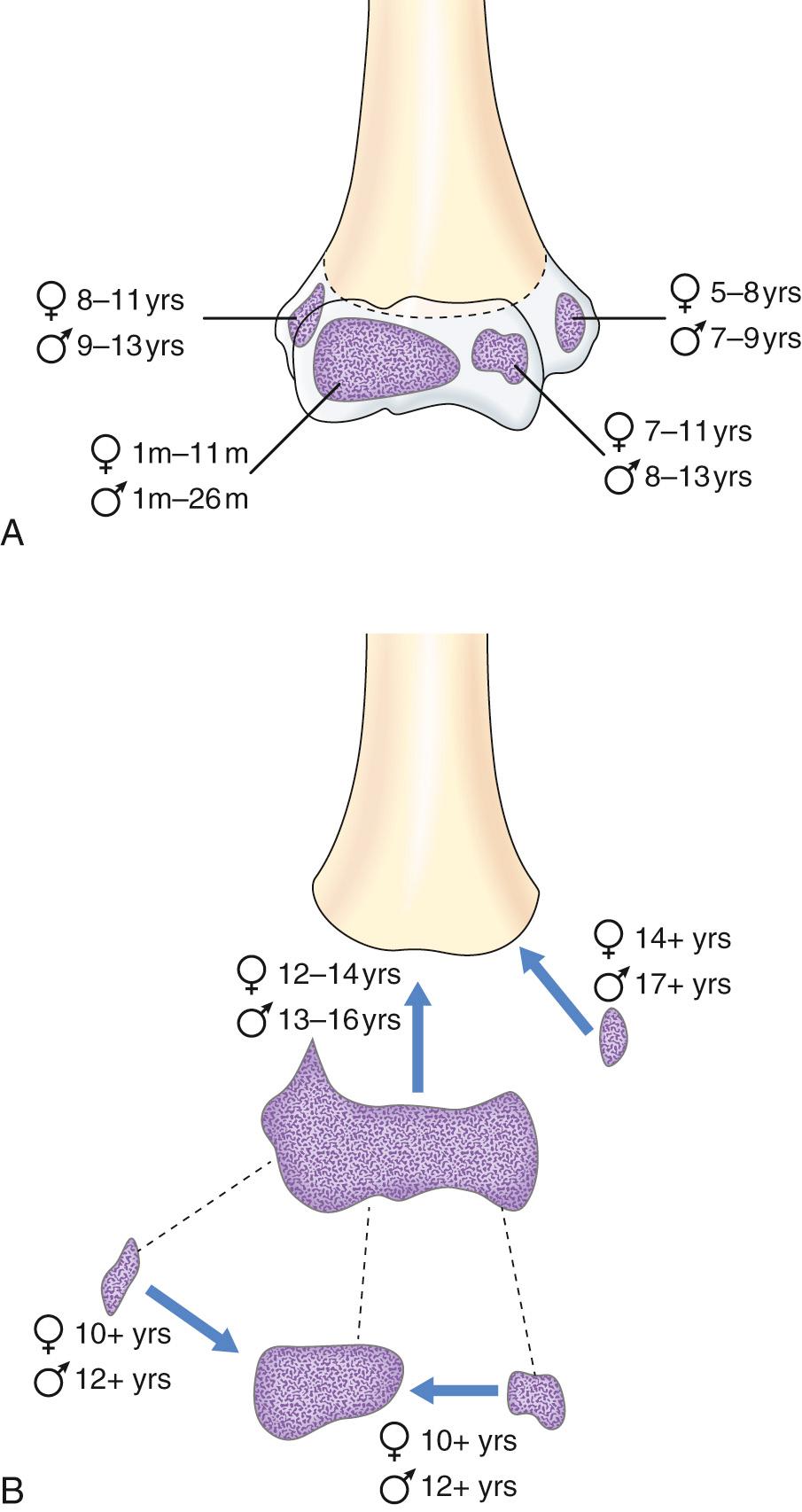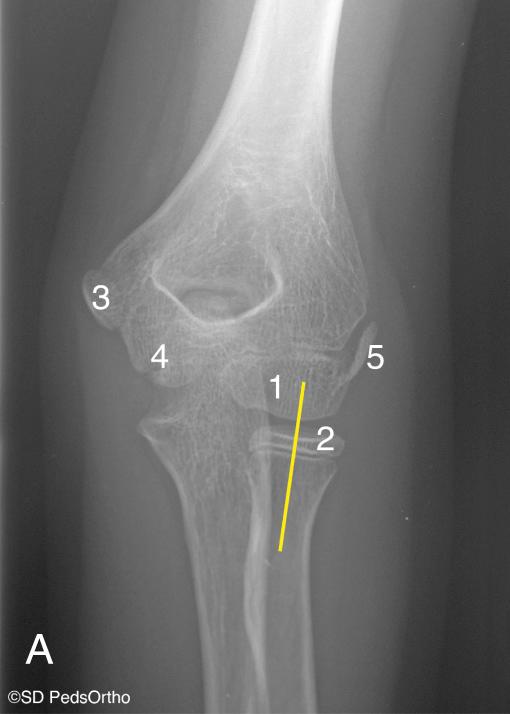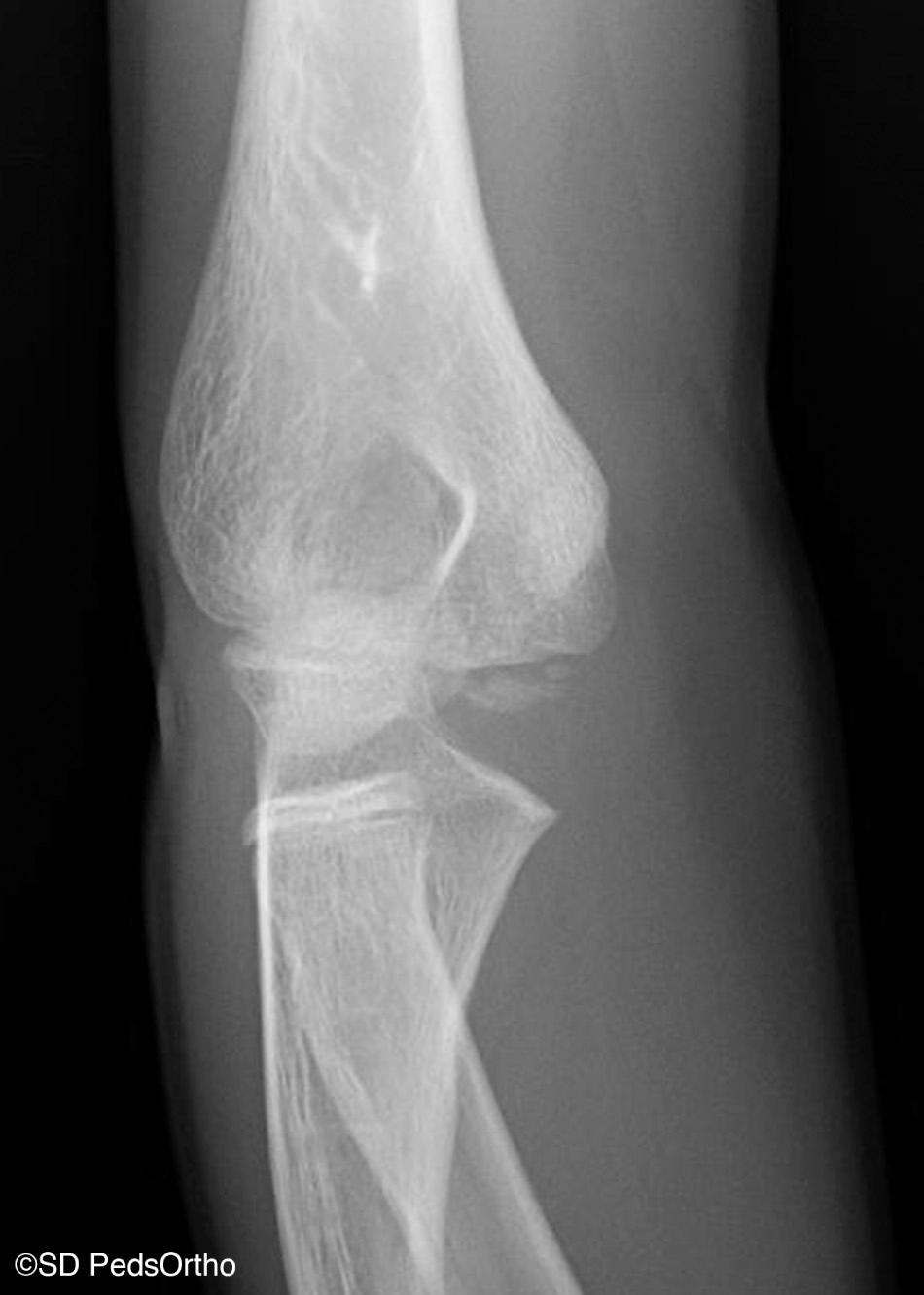Physical Address
304 North Cardinal St.
Dorchester Center, MA 02124
Upper extremity injuries account for the majority of pediatric fractures, with injuries to the elbow occurring with a frequency second only to radius fractures. The majority of pediatric elbow fractures occur within the distal humerus, with supracondylar humerus fractures being the most common. Fractures of the proximal radius, lateral condyle, medial epicondyle, and olecranon are also among the more common fractures seen in a child's elbow. Whereas acute fractures are the basis for the majority of acute pediatric elbow complaints requiring imaging, a number of other conditions require radiographs and advanced imaging for diagnosis.
The six secondary ossification centers of the elbow coalesce to form the complex hinge and rotatory articulations of the distal humerus, olecranon, and radial head and neck. The chronologic order of ossification center appearance is important to understand when evaluating a radiograph of the elbow, but exact timing remains debatable.
Historically, the acronym “CRITOE” has been utilized to describe such an order, representing the capitellum, radial head, internal (medial) epicondyle, trochlea, olecranon, and external (lateral) epicondyle. However, a more recent study in a Chinese population revealed a slightly different pattern, reversing the order of the trochlea and olecranon; furthermore, this study reaffirmed previously published results that genetic and racial factors affect the ossification patterns ( Table 25.1 ).
| Girls | Boys | |
|---|---|---|
| Capitellum | 1 a | 1 |
| Radial head | 5 | 6 |
| Medial epicondyle | 5 | 7.5 |
| Olecranon | 8.7 | 10.5 |
| Trochlea | 9 | 10.7 |
| Lateral epicondyle | 10 | 12 |
Whether the historic or newer data are utilized, a few consistent conclusions can be acknowledged. First, ossification center appearances and fusion of the elbow in males, with exception of the appearance capitellum, lag behind the corresponding appearances and fusion in females, at times by over 2 years. Second, the capitellar ossification center is predictably the first to form. Third, the lateral epicondyle is the last ossification center to form. Finally, the medial epicondyle is the last secondary ossification center to unite. Fig. 25.1 depicts the mean age of appearance for each sex, as well as the typical age of physeal closure.

To dependably evaluate radiographs of the pediatric elbow, each of the secondary centers of ossification must be analyzed. The expected order and age of appearance, maturation, and fusion must be considered when evaluating elbow films. Obtaining the contralateral elbow for comparison can be a helpful aid in making clinical decisions regarding the secondary centers of ossification. The following section will outline important points in the development and maturation of the secondary ossification centers.
Typically ossifying between 6 and 18 months of age, the capitellum provides a well-established anatomical reference when assessing elbow alignment. As the first ossification center to appear, it has pride of place in assessing for sagittal deformity via the anterior humeral line in supracondylar humerus fractures or when evaluating for possible radiocapitellar malalignment via the radiocapitellar line ( Fig. 25.2A,B ). The ossification center typically appears spherical and then elongates into an oval to include the lateral aspect of the trochlea with increasing age. The capitellum is situated anteriorly and tends to be wider posteriorly than anteriorly. The ossification begins eccentrically, located initially anterior and medial and then proceeds posterior and laterally as ossification continues. The capitellum will frequently fuse with the trochlea and lateral epicondyle prior to fusing with the distal humerus.

The initial ossification of the proximal radial epiphysis occurs at approximately the same time as the medial epicondyle, during the fifth to sixth year. The radial head epiphysis originally appears as a thin ellipse and ultimately, with maturity, flattens and develops a concavity to form its articulation with the capitellum. In infancy the radial neck typically appears medially angulated, which should not be interpreted as a proximal radial dislocation unless confirmed on other radiographic views. Further confusion on anteroposterior (AP) views also occurs when the epiphysis first ossifies, as the lateral physis is typically wider than the medial physis, and proximal metaphyseal clefts and notches are commonly seen as normal variants. The ossification of the radial head may appear irregular or bipartite, also causing misinterpretation as a fracture.
The ossification center of the medial epicondyle typically appears at approximately 5 to 7 years of age, around the same time as the radial head epiphysis. Although it appears at a relatively early age, it is the last center to unite with the humeral shaft. Although uncommon, the medial epicondyle ossification center can be multicentric and easily mistaken for an avulsion injury. As an apophysis serving as the origin of flexor pronator mass, the medial epicondyle is extraarticular. In addition to the flexor pronator mass, it serves as the attachment point for the key stabilizer to valgus stress on the elbow, the medial ulnar collateral ligament. Its normal radiographic location just anterior to the posterior humeral line on lateral radiographs and just distal to the distal extent of the olecranon fossa has been well described and can be utilized when attempting to assess for displacement in addition to oblique and axial radiographs (see Fig. 25.2 ).
The trochlear epiphysis typically ossifies at approximately 9 to 10 years of age. Its ossification has a large degree of variability. Multiple centers of ossification within the trochlea are common ( Fig. 25.3 ). Prior to fusion with the distal humerus, the trochlea will typically fuse to the capitellum. It is rarely encountered as an isolated fracture in the pediatric population but may be involved in the medial extent of lateral condyle fractures.

Become a Clinical Tree membership for Full access and enjoy Unlimited articles
If you are a member. Log in here